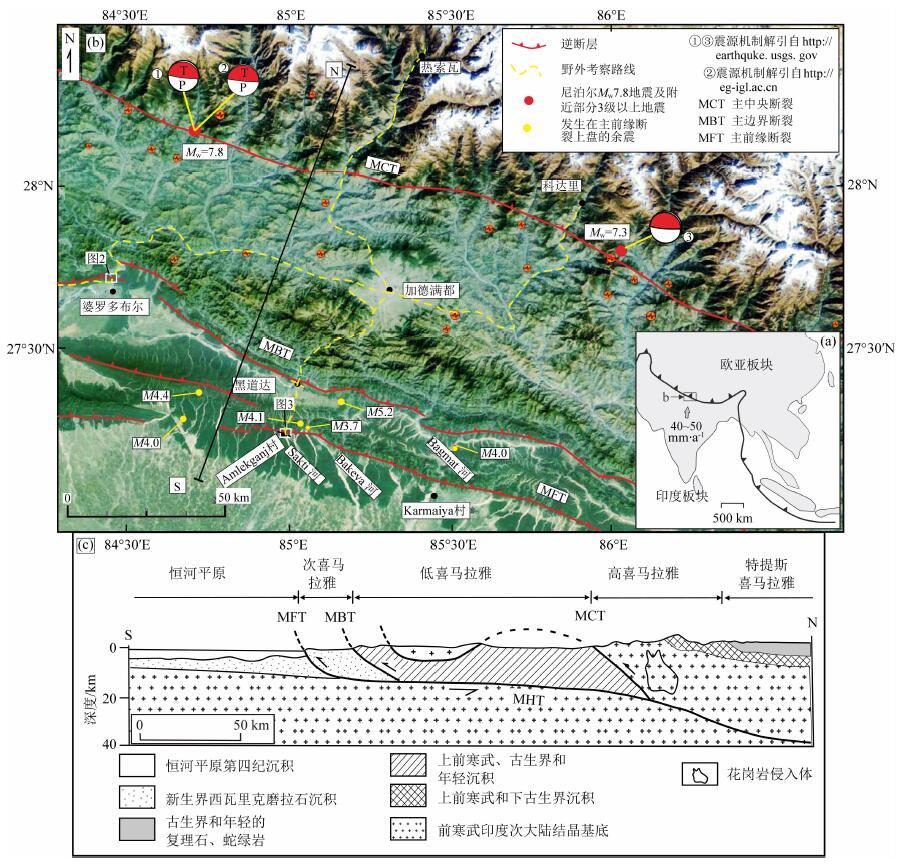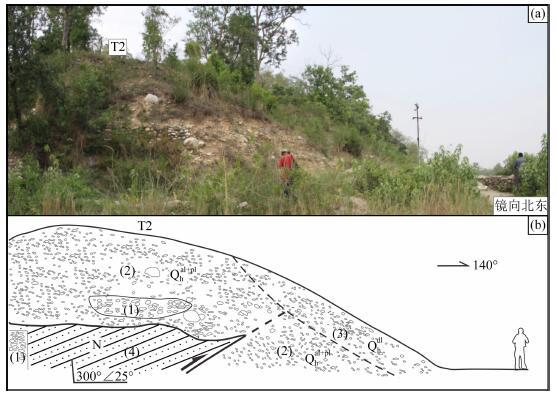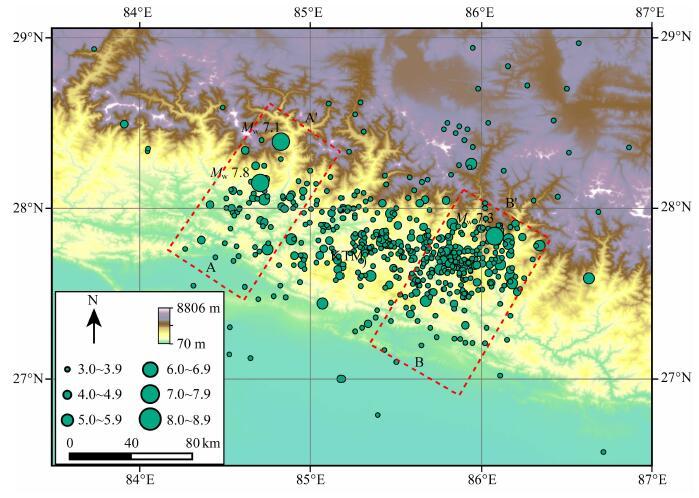2. 中国地震局地质研究所, 北京 100029
2. Institute of Geology, China Earthquake Administration, Beijing 100029, China
北京时间2015年4月25日,位于青藏高原南缘、喜马拉雅山南麓的尼泊尔境内发生MW7.8地震(震中位置84.71°E,2 8.15°N),美国地质勘探局给出的震源深度15 km(http://earthquake.usgs.gov/),中国地震台网给出的震源深度为20 km.中国地震局地质研究所使用点源模型反演得到两组发震断层面参数:节面I:走向95.1°,倾角84.1°,滑动角75.9°;节面II:走向289.3°,倾角6.1°,滑动角104.1°(http://www.eq-igl.ac.cn).美国地质勘探局给出的两组发震断层面参数为:节面Ⅰ:走向295°,倾角11°,滑动角108°;节面Ⅱ:走向96°,倾角79°,滑动角87°.从震源参数看,这次地震为典型的逆冲破裂型地震.喜马拉雅造山带位于青藏高原的南缘,包含11个大致平行的构造单元,其中主要的断裂构造有喜马拉雅主前缘断裂(MFT)、喜马拉雅主边界断裂(MBT)、喜马拉雅主中央断裂(MCT)和藏南拆离断层(SDT)(尹安,2006).自23 Ma以来,喜马拉雅山南坡最显著的地质构造是发育MFT、MBT和MCT三条近平行的逆冲断裂带,它们以垂直于造山带走向的挤压变形为特征,现今的缩短速率为17~18 mm·a-1(Jade et al.,2004).喜马拉雅主边界断裂和喜马拉雅主前缘断裂晚第四纪以来仍在活动(Nakata,1989;Ponraj et al.,2010),特别是在喜马拉雅主前缘断裂(MFT)上陆续发现了断错地表的古地震破裂带(Lavé et al.,2005;Kumar et al.,2006),然而对1934年尼泊尔MW8.1地震是否存在地表破裂亦存在争议(Pandey and Molnar,1988;Tapponnier et al.,2010;Sapkota et al.,2010).
发震构造是指曾发生和可能发生破坏性地震的地质构造.尼泊尔MW7.8地震发生在加德满都以西北约77 km,位于1934年尼泊尔MW8.1地震和1505年尼泊尔MW8.2地震之间的空区(Kumar et al.,2010;Bilham,2015),而在此地震空区内于1833年发生过MW7.3地震(Kumar et al.,2010).青藏高原板内的地震活动与其板块边界构造带的地震活动密切相关,到2014年底,昆仑-汶川地震序列中在青藏高原南部边界尚未发生8.0级及以上地震(邓起东等,2014),尼泊尔MW7.8地震是不是昆仑-汶川地震序列中发生在青藏高原南部边界最大的大于等于8.0级地震还有待进一步观察.大地震的发生和其所处的构造环境密不可分,本文从这方面入手讨论尼泊尔 MW7.8地震的发震构造,期望获得挤压构造环境下低倾角逆冲型特大地震的发震构造特征.新生代以来,受印度板块的持续向北推挤,青藏高原东北缘、北缘的河西走廊和塔里木盆地南缘地区,以及天山地区均处在挤压构造环境下,历史上这些地区已经发生了多次7.5级以上的大地震,弄清大地震的发震构造,可为我国西部地区的防震减灾工作提供理论支持.
2 尼泊尔MW7.8地震区域地质背景始新世以来,印度板块和欧亚板块沿长约2500 km 的板块边界碰撞形成喜马拉雅造山带,累计的地壳缩短约为2000~3000 km(Molnar and Tapponnier,1975)(图 1a).板块之间的碰撞在喜马拉雅山南侧产生了3条和喜马拉雅弧平行的逆冲断裂(图 1b),最北侧的一条断裂为主中央断裂(MCT),它构成高喜马拉雅和低喜马拉雅的分界,北倾30°~45°.主中央断裂的南侧为主边界断裂(MBT),构成低喜马拉雅和次喜马拉雅的边界,它由一系列北倾的逆冲断裂构成,在一些地点,主边界断裂使前第三纪地层逆冲到第四纪地层之上(Nakata,1989).最南侧的一条为主前缘断裂(MFT),它构成地表能够看到的印度板块与青藏地块的分界,使得新生界的西瓦里克组逆冲到恒河平原第四纪沉积之上(Ni and Barazangi,1984)(图 1c).地表这3条近平行、北倾的逆冲断裂向下归并到统一的滑脱断层上,即主喜马拉雅断裂(MHT)(图 1c)(Brown et al.,1996).

|
图 1 尼泊尔MW7.8地震区域主要断层分布和地质剖面图 Fig. 1 The main fault and geological profile in the area of MW7.8,Nepal |
现今GPS观测资料说明,印度板块与欧亚板块之间的汇聚速率约为40~50 mm·a-1(图 1a)(Paul et al.,2001),其中沿喜马拉雅主前缘断裂吸收了约10~20 mm·a-1的缩短速率(Wesnousky et al.,1999; Lavé and Avouac,2000; Wang et al.,2001; Kumar et al.,2001).沿喜马拉雅山南坡发生的几次主要历史地震被认为是发生在主中央断裂带以北的高喜马拉雅地区,震源破裂沿主喜马拉雅断裂(MHT)发生且向南扩展,甚至到达喜马拉雅主前缘断裂(Seeber and Armbruster,1981).如1945年Kangra地震(MW~7.7)、1934年Bihar-Nepal地震(MW~8.1)和1950年Assam地震(MW~8.4)被认为是沿主喜马拉雅逆冲断层破裂,其同震位错扩展到喜马拉雅主前缘断裂(Pandey and Molnar,1988; Chander,1989; Molnar and Pandey,1989).
3 区域主要断裂的活动特征2015年4月25日尼泊尔MW7.8地震区域范围内有三条主要的断裂,它们分别为主中央断裂(MCT)、主边界断裂(MBT)和主前缘断裂(MFT)(图 1b).以下分别叙述它们晚第四纪以来的活动特征.
3.1 主中央断裂(MCT)尼泊尔境内的主中央断裂为一个2~10 km宽的剪切带(Macfarlane et al.,1992),表现为断坡-断坪几何特征(DeCelles et al.,2001).在逆冲推覆构造系统中,断坡区域通常称为跟带,倾角30~45°,沿此构造部位强烈的地震活动、高导电性与断坡有关,可能暗示了有应力集中和沿断坡有流体存在(Lemonnier et al.,1999;Pandey et al.,1999;Avouac,2003).尼泊尔东部的平衡地质剖面研究说明,MCT可能产生了大约140~210 km的位移(Schelling,1992),其开始形成的时代大约为23—20 Ma的中新世早期(Arita,1983).MCT在3—8 Ma的晚中新世-始新世有过一次强烈活动(Catlos et al.,2001),第四纪以来未见活动的证据(尹安,2006).2015年尼泊尔MW7.8地震之后,Collins和Jibson(2015)对地震区的滑坡地质灾害进行了现场调查和灾害评估,他们的调查区覆盖了喜马拉雅主中央断裂(MCT)出露的位置,但没有发现地震地表破裂沿主中央断裂带分布的现象,仅在该地区发现了大量的滑坡等地震地质灾害(http://dx.doi.org/10.3133/ofr20151142).另外一支由多国科学家组成的调查队采用地面实地考察和直升机空中侦察的方式,对尼泊尔MW7.8地震区的建筑破坏、砂土液化、地表裂缝等进行了综合考察,其考察地区也覆盖了地震区喜马拉雅主中央断裂(MCT)展布的地区,他们也没有发现沿喜马拉雅主中央断裂存在地震地表破裂的迹象(http://geerassociation.org/GEER-Post%20EQ%Reports/Nepol-2015/index.html).Parameswaran等(2015)在尼泊尔MW7.8主震震中以南约30 km的Phujel一带,发现了一些走向近南北和近东西的地表裂缝,这些裂缝发育在靠近河床的陡坡地带,或分布在山脊上,它们的形成可能与地震动效应、或与盲逆断层相关的褶皱同震活 动有关.我们的考察路线也延伸到中尼边界附近尼泊尔一侧的科达里(KODARI)和热索瓦(RASUWA)一带(图 1),沿喜马拉雅主中央断裂(MCT)及其附近没有发现地震地表破裂,但分布有大量的滑坡、崩塌等地震地质灾害现象.依据我们的考察和收集到的文献资料,至今未见喜马拉雅主中央断裂晚第四纪活动的证据,也未见沿该断裂带发育尼泊尔MW7.8地震地表破裂带的依据.
3.2 主边界断裂(MBT)Powell和Conaghan(1973)推断主边界断裂(MBT)的滑移距离超过100 km,关于其形成的年代,Meigs等(1995)由沉积速率变化推断其早于11 Ma,而DeCelles等(1998)依据断层上盘加入喜马拉雅前陆盆地的粗粒碎屑沉积物推断其形成晚于5 Ma.地貌上,主边界断裂以南为海拔300~500 m的低山,以北为海拔1200~1500 m的中高山区.
在尼泊尔 MW7.8地震主震震中南侧的婆罗多布尔附近(图 1),根德格河(Gandak River)西岸发育三级阶地(图 2a).根据Google地球提供的数据,在逆冲断层的上盘(断裂北侧)发育三级阶地,从低到高三个阶地的拔河高度分别为20 m、44 m和80 m;在逆冲断层的下盘(断裂南侧)发育两级河流阶地,从低到高两个阶地的拔河高度分别为12 m和23 m.T1阶地上断层陡坎的高度约为5~6 m,T2阶地上断层陡坎的高度约为10 m,T3阶地上的断层陡坎高度至少为50 m(图 2b).经过野外考察,在婆罗多布尔地区的喜马拉雅主边界断裂带上未发现尼泊尔MW7.8地震的地表破裂带.

|
图 2 婆罗多布尔附近活动断裂卫星影像解释图 (a)婆罗多布尔附近构造地貌解释图;(b)河流西岸被断错的阶地、断层陡坎及陡坎高度; T1、T2和T3为阶地编号,从低到高依次标示为T1、T2和T3. Fig. 2 The active fault map from satellite image near the Bharatpur (a)Tectonic geomorphology interpretation near the Bharatpur;(b)The faulted terrace,fault scarp and the height of fault scarp. T1,T2,T3:terrace number. |
Nakata(1989)研究了尼泊尔西部佩里河(Bheri River)的阶地,认为主边界断裂错断了河流阶地,其中高阶地上的断层陡坎高度至少为90 m,低阶地上的断层陡坎高12~15 m,高、低阶地之间的阶地上断层陡坎高度约55 m,且发现了低角度的逆冲断层错断距今14C 年龄为1400年左右的年轻砂砾石层.2005年克什米尔发生了MW7.6地震,这次地震沿喜马拉雅主边界断裂(MBT)形成地震地表破裂(Kaneda et al.,2008).
Collins和Jibson(2015)、GEER Association Report No.GEER-040(2015)对尼泊尔MW7.8地震的震后科学考察亦覆盖了喜马拉雅主边界断裂(MBT),沿该断裂没有发现有关这次地震地表破裂带的痕迹.Parameswaran等(2015)的考察路线多处穿越了喜马拉雅主边界断裂(MBT),其中部分路线与我们的考察路线重叠,如黑道达、婆罗多布尔附近(图 1),沿喜马拉雅主边界断裂(MBT)也没有发现尼泊尔MW7.8地震的地表破裂.
以上资料说明,尼泊尔中、西部和克什米尔的喜马拉雅主边界断裂为全新世活动断裂,而且2005年克什米尔MW7.6地震使其西段产生地震地表破裂.位于2015年尼泊尔MW7.8地震震中以南的喜马拉雅主边界断裂(MBT)上至今未发现本次地震的地表破裂.
3.3 主前缘断裂(MFT)喜马拉雅主前缘断裂(MFT)使新近纪西瓦里克组陆相沉积物向南逆冲到恒河平原的第四纪沉积 物之上(Nakata,1989;Kumar et al.,2006;Kumar et al.,2010).在主前缘断裂向南逆冲过程中,其上盘的西瓦里克组发生褶皱变形,Lavé和Avouac(2000)用断层上盘变形地貌面和形成年代确定主前缘断裂的滑动速率,得到的滑动速率(21±1.5 mm·a-1)与穿过喜马拉雅的GPS结果(18±2 mm·a-1)相近(Larson et al.,1999).近年来,Lavé等(2005)在主前缘断裂中段揭露出发生在公元1100年的古地震事件,Kumar等(2006,2010)在喜马拉雅主前缘断裂东段和西北段发现错断晚全新世地层的证据,而且揭露出两次古地震事件.Sapkota等(2013)在1934年尼泊尔地震(MW8.2)震中区南侧的喜马拉雅主前缘断裂上发现了这次地震的地表破裂带,证实了这次地震为破裂地表的地震事件.
2015年尼泊尔MW7.8地震及其强余震(MW7.3)区南侧的Amlekganj村附近(图 1),Sakti河两岸发育了3级阶地(图 3).其中,T1阶地拔河高度6 m 左右,T2阶地拔河高度12~15 m,T3阶地拔河高度约为50 m.现代河床中,断层以南为砂砾石堆积区,卫星影像上表现为白色;而在断层以北砂岩裸露于河床中,卫星影像上表现为灰色(图 3a).

|
图 3 黑道达南Amlekganj村附近卫星影像(a)和构造解释图(b) Fig. 3 Satellite image(a)and tectonic interpretation(b)near the Amlekganj vallige,at the southern side of Hetauda |
图 4为Amlekganj村附近断错地貌照片和野外实测得到的断层陡坎高度.利用激光测距仪实测得到,T1阶地上的断层陡坎高度为2.5 m,T2阶地上的断层陡坎高度为10 m左右(图 4a、4b、4c).断层以北的现代河床中,出露的地层为西瓦里克组灰色粉砂岩,而断层以南的河床中为现代冲洪积砂砾石(图 4c).

|
图 4 Amlekganj村附近断错地貌照片 Fig. 4 The photographs about faulted landform,near the Amlekganj village |
在图 4a所示的河流东岸T2阶地前缘陡坎处,河流冲刷使得喜马拉雅主前缘断裂(MFT)出露于地表(图 5).剖面上部为T2阶地冲洪积砂砾石层,下部为西瓦里克组灰色粉砂岩,可见西瓦里克组砂岩逆冲到全新世的砂砾石之上.由于砂砾石层的崩塌作用,剖面上砂砾石堆积中未见清晰的断层面,但可以看出断层上盘的砂砾石层近水平产出,断层下盘的砂砾石层向南倾斜(图 5b).
另外,在河床及其河流西岸的阶地、Amlekganj 村附近穿越断层陡坎的公路上均未见尼泊尔MW7.8 地震形成的地表破裂.
4 尼泊尔MW7.8地震及余震的空间分布特征地震目录来自国际地震中心(ISC,International Seismological Centre,http://www.isc.ac.uk/),时间从2015年4月25日至2015年6月19日,震级为M3以上,共521条地震记录,其中包含震源深度记录的为143条.
4.1 尼泊尔MW7.8地震及余震的平面分布Pandey等(1999)收集分析了尼泊尔及其邻区 1994年5月至1998年1月期间大于等于2级的地震数据,结果发现尼泊尔地区的地震大致沿高喜马拉雅前缘的狭窄条带内分布.Pandey等(1995)利用1985—1995年间加德满都周围台网记录到的尼泊尔中部地区地震活动数据也揭示了同样的地震分布特征.

|
图 5 河流东岸断层地质剖面 (1) 人工堆砌的石墙;(2) 全新世冲洪积砂砾石层;(3) 全新世坡积砾石;(4) 新近纪砂岩. Fig. 5 The geological profile and photograph (1) Man-made wall;(2) Holocene alluvial sand and gravel;(3) Holocene slope deposit;(4) Neogene sand stone. |
图 6给出了尼泊尔MW7.8地震及其余震的平面分布.从图中可以看出,尼泊尔MW7.8地震及其余震大致沿北西向的高喜马拉雅山前缘分布,主要分布在低喜马拉雅山区内,其条带宽度约为180 km,宽约80 km.这次地震的主震(MW7.8)、两个MW≥7.0级的余震分布位于北西向条带的西段和东段,也分布在高喜马拉雅与低喜马拉雅的过渡地带内.

|
图 6 尼泊尔MW7.8地震及余震分布图KTM:加德满都;蓝色圆点为尼泊尔MW7.8地震及其大于等于3级的余震,时间段为2015年4月25日—6月19日. Fig. 6 The main earthquake and aftershocks of MW7.8 event,Nepal |
刘静等(2015)从地震波反演时间快照资料得到尼泊尔MW7.8地震的大位移区域由西北向南东扩展的过程.Wang和Fialko(2015)利用地表测量数据(GPS和ALOS-2)反演了尼泊尔MW7.8地震发震断层的几何形态和同震滑动分布,认为这次地震的发震断层为一条倾向北、倾角7°的逆冲断层,且这条断层与地表出露的喜马拉雅主前缘断裂(MFT)相连.地震时发震断层错动的位置位于距离主前缘断裂50~100 km以北的断层深部,最大同震错动约为5.8 m.Avouac等(2015)利用远震记录和合成孔径干涉雷达图像反演了2015年尼泊尔MW7.8地震的破裂过程,结果认为,这次地震的起 始破裂位于主喜马拉雅断裂(MHT)闭锁段的下缘,然后向东扩展约140 km,破裂扩展速率约2.8 m·s-1,但明显的没有向南扩展到主喜马拉雅断裂(MHT)地表出露的位置,即震源破裂没有扩展到喜马拉雅主前缘断裂(MFT).他们进一步推测,地震造成的应力转移势必影响到震区以南主喜马拉雅断裂(MHT)上倾段的未来破裂.国内单新建等(2015)、刘刚等(2015)也反演了2015年尼泊尔MW7.8地震的破裂过程,得到的结果与Wang和Fialko(2015)、Avouac等(2015)大体一致.
4.2 尼泊尔MW7.8地震震源深度分布尼泊尔地震台网的记录表明,现代小震活动集中分布在高喜马拉雅地形陡坡带之下的10~20 km的深度,平面上呈狭窄的带状分布(Pandey et al.,1995),小震活动分布条带也是水准测量获得的抬升速率较高的部位(Jackson et al.,1992;Bilham et al.,1997).对比尼泊尔中部的地质构造剖面,可以发现小震活动带与低喜马拉雅和高喜马拉雅过渡带之下推测的主滑脱断裂上的断坡位置一致(Pandey et al.,1999),即小震震中集中分布的位置与Zhao等(1993)深地震反射资料解释的断坡的位置一致(图 7c).

|
图 7 尼泊尔MW7.8地震震源深度剖面 其中(a)、(b)图下部的逆冲断层参照Zhao等(1993)、Brown等(1996)、Pandey等(1999)的资料;(a)包含2015年4月25日尼泊尔MW7.8地震主震、及其宽52 km北东向矩形范围内余震的震源深度剖面;(b)包含2015年5月12日MW7.3余震、及其宽64 km北东向矩形范围内余震的震源深度剖面.红色粗线段表示主喜马拉雅滑脱断裂上的断坡,紫色细线段表示主喜马拉雅断裂的近水平段(断坪)、及其浅部的断坡.(a)、(b)图上部为尼泊尔MW7.8地震区西部、东部地质剖面图,MFT、MBT、MCT和MHT分别表示喜马拉雅主前缘断裂、喜马拉雅主边界断裂、喜马拉雅主中央断裂和主喜马拉雅断裂,MFT和MBT之间为形态较简单的西瓦里克背斜,MBT和MCT之间为复杂的褶皱带;(c)INDEPT 地震和MT 的地壳结构解译、现代小地震分布以及断裂几何的构造剖面图(刘静等,2015). Fig. 7 The depth profile of MW7.8 event and aftershocks,Nepal |
图 7是来自国际地震中心2015年4月25日至2015年6月19日期间的地震资料.图 7a下图为包含尼泊尔MW7.8地震主震、宽52 km的北东向条带内、具有震源深度数据地震的震源深度剖面图;图 7b下图为包含尼泊尔MW7.8地震最大的余震(MW7.3 地震)、宽64 km的北东向条带内、具有震源深度数据地震的深度剖面图.虽然这些地震没有经过精确定位,但从以上2个图中仍然可以看到,尼泊尔MW7.8地震的余震大致分布在主喜马拉雅滑脱断裂的上盘推覆体内,主震(MW7.8)发生在高喜马拉雅与低喜马拉雅过渡带之下的断坡上,而主余震(MW7.3)则发生在高喜马拉雅之下的断坡上,主震和主余震分别发生在主喜马拉雅断裂(MHT)深部断坡的不同部位.主震的发生与震前闭锁的断坡从下缘开始破裂有关(Avouac et al.,2015),地震时主喜马拉雅断裂(MHT)上盘的褶皱带向南逆冲,且褶皱带同时发生褶皱变形引起褶皱带内相关断层发生次级错动,从而引发大量的余震在褶皱带内发生.喜马拉雅主中央断裂(MCT)附近也存在大量的余震活动,我们不排除尼泊尔MW7.8地震的余震沿喜马拉雅主中央断裂(MCT)的深部发生小位移的错动而产生地震,但目前还没有发现沿喜马拉雅主中央断裂(MCT)产生地表破裂的证据.
5 尼泊尔MW7.8地震发震构造分析水准测量资料显示,沿高喜马拉雅前缘存在一个隆起的条带,且隆起带的位置与高喜马拉雅前缘的微震活动条带在空间上具有一致性(Jackson et al.,1992;Pandey et al.,1995;Bilham et al.,1997). 可以推测,沿高喜马拉雅山前条带状的微震活动反映了大地震间歇期的应力积累.微震活动与尼泊尔中部的构造剖面对比,进一步发现微震活动的位置与主喜马拉雅滑脱断裂上断坡的位置一致,沿断坡的位置微震活动成束状分布(Pandey et al.,1999).主喜马拉雅滑脱断裂上断坡的存在被深反射地震资料证实(Zhao et al.,1993).这种对应关系表明,主喜马拉雅滑脱断裂上断坡在大地震发生的间歇期表现 为一个障碍体,起到应力和应变积累的作用(Pandey et al.,1995).
GPS资料(Jackson and Bilham,1994;Bilham et al.,1997)显示,在大地震的间歇期主喜马拉雅滑脱断裂上的断坪、断坡处于闭锁状态(Pandey et al.,1995).大地测量资料揭示出高喜马拉雅之下以21±3 mm·a-1的速率持续的发生蠕滑运动(Pandey et al.,1995),而这个速率与喜马拉雅主前缘断裂长期的缩短速率21.5±2 mm·a-1(Lavé and Avouac,2000)基本一致.鉴于这个事实,Pandey等(1999)进一步推测主喜马拉雅断裂(包含其上的断坡和断坪)仅仅在大地震发生时产生错动,把积累的变形传递到喜马拉雅最南侧的前缘构造带(Pandey et al.,1995; Lavé and Avouac,2000).
2015年4月25日尼泊尔MW7.8地震的主震及其最大余震分别发生在该地震构造区的东西两端,其震源位于主喜马拉雅断裂上倾角较陡的段落(断坡).刘静等(2015)根据地壳尺度增生楔理论模型推断该断坡的倾角约为10°,断坪段的倾角约为7°,主喜马拉雅断裂的深部几何结构以断坡-断坪为基本特征(图 1c、图 7c).USGS给出的震源机制解显示,尼泊尔MW7.8地震的发震断层倾角为11°,与主喜马拉雅断裂上断坡的倾角基本一致.主喜马拉雅断裂上的断坡具备障碍体特征,为尼泊尔MW7.8地震的发震构造.余震主要分布在主喜马拉雅断裂上盘的推覆体内,平面为一个长180 km、宽80 km的矩形条带,说明这次尼泊尔地震的震源破裂沿主喜马拉雅断裂向南扩展,引起其上盘的褶皱带缩短变形,局部产生小规模的破裂而发生地震.如黑道达南的5次3.7~4.6级余震均发生在主前缘断裂和主边界断裂之间的西瓦里克褶皱带中(图 1),震源深度约10 km(USGS地震数据).
6 结论本次野外实地调查点跨越了2015年4月25日尼泊尔MW7.8地震震中区以南的喜马拉雅主中央断裂(MCT)、主边界断裂(MBT)和主前缘断裂(MFT),在这些调查路线上均未发现尼泊尔MW7.8地震的地表破裂.迄今为止,也未见有关这次地震地表破裂的报道.
尼泊尔MW7.8地震区的地质构造基本特征为薄皮逆冲构造,其前缘发育活动逆冲断裂和褶皱带,其中薄皮逆冲构造之下为向北倾的浅部断坡(陡倾)—深部断坪(缓倾)、断坡(陡倾)系统.其中深部断坡为主喜马拉雅断裂(MHT)上的深部陡倾部分,也是2015年4月25日尼泊尔MW7.8地震的发震构造.绝大多数余震分布在深部断坡-断坪之上的喜马拉雅山南坡褶皱带中,推测为尼泊尔MW7.8地震时地震断层的向南错动,震源处的位错沿深部断坡-断坪向南传播引起其上盘的褶皱带缩短变形,进而触发褶皱带内次级破裂而产生余震.
| Arita K. 1983. Origin of the inverted metamorphism of the Lower Himalayas, Central Nepal. Tectonophysics , 95(1-2): 43–60. | |
| Avouac J P. 2003. Mountain building, erosion, and the seismic cycle in the Nepal Himalaya. Advances in Geophysics , 46: 1–80. | |
| Avouac J P, Meng L S, Wei S J, et al. 2015. Lower edge of locked main Himalayan thrust unzipped by the 2015 Gorkha earthquake. Nature Geoscience , 8(9): 708–711. | |
| Bilham R, Larson K, Freymueller J. 1997. GPS measurements of present-day convergence across the Nepal Himalaya. Nature , 386(6620): 61–64. | |
| Bilham R. 2015. Raising Kathmandu. Nature Geoscience , 8(8): 582–584. | |
| Brown L D, Zhao W J, Nelson K D, et al. 1996. Bright spots, structure, and magmatism in southern Tibet from INDEPTH seismic reflection profiling. Science , 274(5293): 1688–1690. | |
| Catlos E J, Harrison T M, Kohn M J, et al. 2001. Geochronologic and thermobarometric constraints on the evolution of the Main Central Thrust, central Nepal Himalaya. Journal of Geophysical Research , 106(B8): 16177–16204. | |
| Chander R. 1989. Southern limits of major earthquake ruptures along the Himalaya between longitudes 75° and 90°E. Tectonophysics , 170(1-2): 115–123. | |
| Collins B D, Jibson R W. 2015. Assessment of existing and potential landslide hazards resulting from the April 25, 2015 Gorkha, Nepal earthquake sequence (ver.1.1, August 2015): U. S. Geological Survey Open-File Report 2015-1142, 50. http://dx.doi.org/10.3133/ofr20151142. | |
| DeCelles P G, Gehrels G E, Gqade J, et al. 1998. Neogene foreland basin deposits, erosional unroofing, and the kinematic history of the Himalayan fold-thrust belt, western Nepal. Geological Society of America Bulletin , 110(1): 2–21. | |
| DeCelles P G, Robinson D M, Quade J, et al. 2001. Stratigraphy, structure, and tectonic evolution of the Himalayan fold-thrust belt in western Nepal. Tectonics , 20(4): 487–509. | |
| Deng Q D, Cheng S P, Ma J, et al. 2014. Seismic activities and earthquake potential in the Tibetan Plateau. Chinese Journal of Geophysics (in Chinese) , 57(7): 2025–2042. doi: 10.6083/cjg20140701. | |
| GEER Association Report No. GEER-040, April 25, 2015 Gorkha, Nepal Earthquake Report for Web Dissemination (http://geerassociation.org/GEER_Post%20EQ%20Reports/Nepal_2015/index.html) | |
| Jackson M, Barrientos S, Bilham R, et al. 1992. Uplift in the Nepal Himalaya revealed by spirit leveling. Geophysical Research Letters , 19(15): 1539–1542. | |
| Jackson M, Bilham R. 1994. Constraints on Himalayan deformation inferred from vertical velocity fields in Nepal and Tibet. Journal of Geophysical Research , 99(B7): 13897–13912. | |
| Jade S, Bhatt B C, Yang Z, et al. 2004. GPS measurements from the Ladakh Himalaya, India: Preliminary tests of plate-like or continuous deformation in Tibet. Geological Society of America Bulletin , 116(11-12): 1385–191. | |
| Kaneda H, Nakata T, Tsutsumi H, et al. 2008. Surface rupture of the 2005 Kashmir, Pakistan, earthquake and its active tectonic implications. Bull. Seismol. Soc. Am. , 98(2): 521–557. | |
| Kumar S, Wesnousky S G, Rockwell T K, et al. 2001. Earthquake recurrence and rupture dynamics of Himalayan frontal thrust, India. Science , 294(5550): 2328–2331. | |
| Kumar S, Wesnousky S G, Rockwell T K, et al. 2006. Paleoseismic evidence of great surface rupture earthquakes along the Indian Himalaya. Journal of Geophysical Research, 111: B03304, doi: 10.1029/2004JB003309. | |
| Kumar S, Wesnousky S G, Jayangondaperumal R, et al. 2010. Paleoseismological evidence of surface faulting along the northeastern Himalayan front, India: Timing, size, and spatial extent of great earthquakes. Journal of Geophysical Research, 115: B12422, doi: 10.1029/2009JB006789. | |
| Larson K M, Bürgmann R, Bilham R, et al. 1999. Kinematics of the India-Eurasia collision zone from GPS measurements. Journal of Geophysical Research , 104(B1): 1077–1093. | |
| Lavé J, Avouac J P. 2000. Active folding of fluvial terraces across the Siwaliks Hills, Himalayas of central Nepal. Journal of Geophysical Research , 105(B3): 5735–5770. | |
| Lavé J, Yule D, Sapkota S, et al. 2005. Evidence for a great Medieval earthquake (~1100 A. D.) in the central Himalayas, Nepal. Science , 307(5713): 1302–1305. | |
| Lemonnier C, Marquis G, Perrier F, et al. 1999. Electrical structure of the Himalaya of central Nepal: high conductivity around the mid-crustal ramp along the MHT. Geophysical Research Letters , 26(21): 3261–3264. | |
| Liu G, Wang Q, Qiao X J, et al. 2015. The 25 April 2015 Nepal MS8. 1 earthquake slip distribution from joint inversion of teleseismic, static and high-rate GPS data. Chinese Journal of Geophysics (in Chinese) , 58(11): 4287–4297. doi: 10.6038/cjg20151133. | |
| Liu J, Ji C, Zhang J Y, et al. 2015. Tectonic setting and general features of coseismic rupture of the 25 April, 2015 MW7. 8 Gorkha, Nepal earthquake. Chinese Science Bulletin (in Chinese) , 60(27): 2640–2655. doi: 10.1360/N972015-00559. | |
| Macfarlane A M, Hodges K V, Lux D. 1992. A structural analysis of the Main Central thrust zone, Langtang National Park, central Nepal Himalaya. Geological Society of America Bulletin , 104(11): 1389–1402. | |
| Meigs A J, Burbank D W, Beck R A. 1995. Middle late Miocene (>10 Ma) formation of the Main Boundary thrust in the western Himalaya. Geology , 23(5): 423–426. | |
| Molnar P, Tapponnier P. 1975. Cenozoic tectonics of Asia: Effects of a continental collision. Science , 189(4201): 419–426. | |
| Molnar P, Pandey M R. 1989. Rupture zones of great earthquakes in the Himalayan region. //Proc.India Acad.Sci.(Earth and Planetary Science) , 98(1): 61–70. | |
| Nakata T. 1989. Active faults of the Himalaya of India and Nepal. GSA Special Papers , 232: 243–264. | |
| Ni J, Barazangi M. 1984. Seismotectonics of the Himalayan collision zone: Geometry of the underthrusting Indian plate beneath the Himalaya. Journal of Geophysical Research , 89(B2): 1147–1163. | |
| Pandey M R, Molnar P. 1988. The distribution of intensity of the Bihar-Nepal earthquake of 15 January 1934 and bounds on the extent of the rupture zone. Journal of Nepal Geological Society , 5(1): 22–44. | |
| Pandey M R, Tandukar R P, Avouac J P, et al. 1995. Interseismic strain accumulation on the Himalayan crustal ramp (Nepal). Geophysical Research Letters , 22(7): 751–754. | |
| Pandey M R, Tandukar R P, Avouac J P, et al. 1999. Seismotectonics of the Nepal Himalaya from a local seismic network. Journal of Asian Earth Sciences , 17(5-6): 703–712. | |
| Parameswaran R M, Natarajan T, Rajendran K, et al. 2015. Seismotectonics of the April-May 2015 Nepal earthquakes: An assessment based on the aftershock patterns, surface effects and deformational characteristics. Journal of Asian Earth Sciences , 111: 161–174. doi: 10.1016/j.jseaes.2015.07.030. | |
| Paul J, Bürgmann R, Gaur V K, et al. 2001. The motion and active deformation of India. Geophysical Research Letters , 28(4): 647–650. | |
| Ponraj M, Miura S, Reddy C D, et al. 2010. Estimation of strain distribution using GPS measurements in the Kumaun region of Lesser Himalaya. Journal of Asian Earth Sciences , 39(6): 658–667. | |
| Powell C Mc A, Conaghan P J. 1973. Plate tectonics and the Himalayas. Earth and Planetary Science Letters , 20(1): 1–12. | |
| Sapkota S N, Tapponnier P, Bolliger L, et al. 2010. Morphotectonics and paleoseismology of the main frontal thrust in the Nepal Himalayas. Journal of Nepal Geological Society , 41(Sp. Issue): 144. | |
| Sapkota S N, Bollinger L, Klinger Y, et al. 2013. Primary surface ruptures of the great Himalayan earthquakes in 1934 and 1255. Nature Geoscience , 6: 71–76. doi: 10.1038/NGEO1669. | |
| Schelling D. 1992. The tectonostratigraphy and structure of the eastern Nepal Himalaya. Tectonics , 11(5): 925–943. | |
| Seeber L, Armbruster J G. 1981. Great detachment earthquakes along the Himalayan Arc and long-term forecasting.// Earthquake Prediction. American Geophysical Union, 259-277. | |
| Shan X J, Zhang G H, Wang C S, et al. 2015. Joint inversion for the spatial fault slip distribution of the 2015 Nepal MW7. 9 earthquake based on InSAR and GPS observations. Chinese Journal of Geophysics (in Chinese) , 58(11): 4266–4276. doi: 10.6038/cjg20151131. | |
| Tapponnier P, Sapkota S N, Klinger Y, et al. 2010. Hunting for the traces of great Himalayan earthquakes: surface break of the M8.1, 1934 Bihar-Nepal event?. Journal of Nepal Geological Society , 1934(Sp. Issue): 124. | |
| Wang K, Fialko Y. 2015. Slip model of the 2015 MW7. 8 Gorkha (Nepal) earthquake from inversions of ALOS-2 and GPS data. Geophysical Research Letters , 42(18): 7452–7458. doi: 10.1002/2015GL065201. | |
| Wang Q, Zhang P Z, Freymueller J T, et al. 2001. Present-day crustal deformation in China constrained by Global Positioning System measurements. Science , 294(5542): 574–577. | |
| Wesnousky S G, Kumar S, Mohindra R, et al. 1999. Uplift and convergence along the Himalayan Frontal Thrust of India. Tectonics , 18(6): 967–976. | |
| Yin A. 2006. Cenozoic tectonic evolution of the Himalayan orogen as constrained by along-strike variation of structural geometry, exhumation history, and foreland sedimentation. Earth Science Frontiers (in Chinese) (in Chinese) , 13(5): 416–515. | |
| Zhao W J, Nelson K D, Che J, et al. 1993. Deep seismic reflection evidence for continental underthrusting beneath southern Tibet. Nature , 366(6455): 557–559. | |
| 邓起东, 程绍平, 马冀, 等. 2014. 青藏高原地震活动特征及当前地震活动形势. 地球物理学报 , 57(7): 2025–2042. | |
| 刘刚, 王琪, 乔学军, 等. 2015. 用连续GPS与远震体波联合反演2015年尼泊尔中部MS8. 1地震破裂过程. 地球物理学报 , 58(11): 4287–4297. | |
| 刘静, 纪晨, 张金玉, 等. 2015. 2015年4月25日尼泊尔MW7. 8级地震的孕震构造背景和特征. 科学通报 , 60(27): 2640–2655. | |
| 单新建, 张国宏, 汪驰升, 等. 2015. 基于InSAR和GPS观测数据的尼泊尔地震发震断层特征参数联合反演研究. 地球物理学报 , 58(11): 4266–4276. | |
| 尹安. 2006. 喜马拉雅造山带新生代构造演化: 沿走向变化的构造几何形态、剥露历史和前陆沉积的约束. 地学前缘 , 13(5): 416–515. | |
 2016, Vol. 59
2016, Vol. 59

